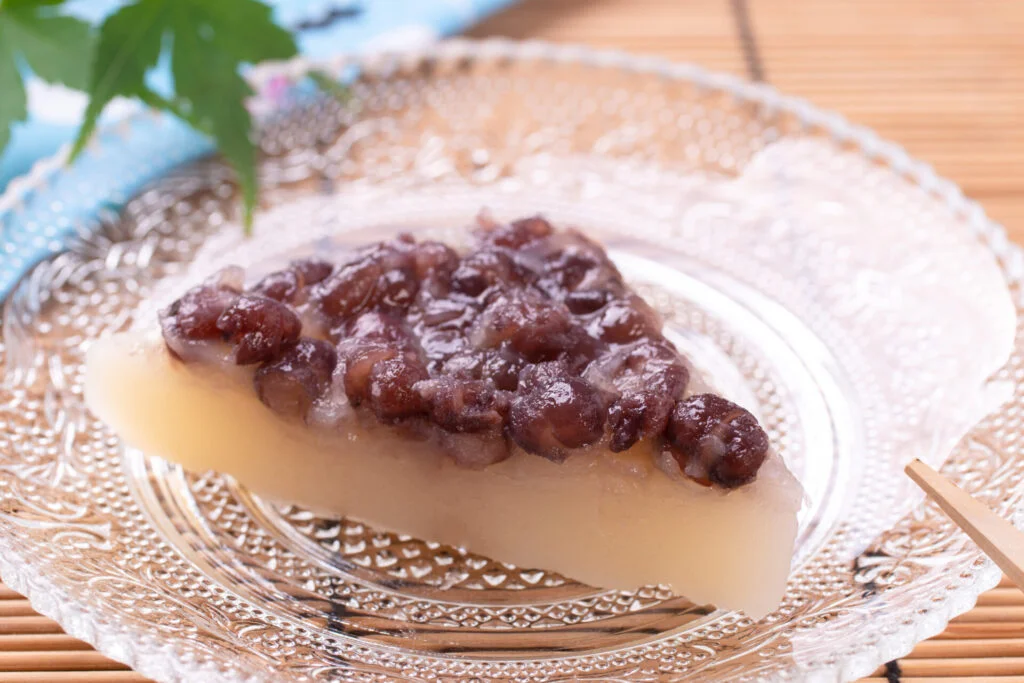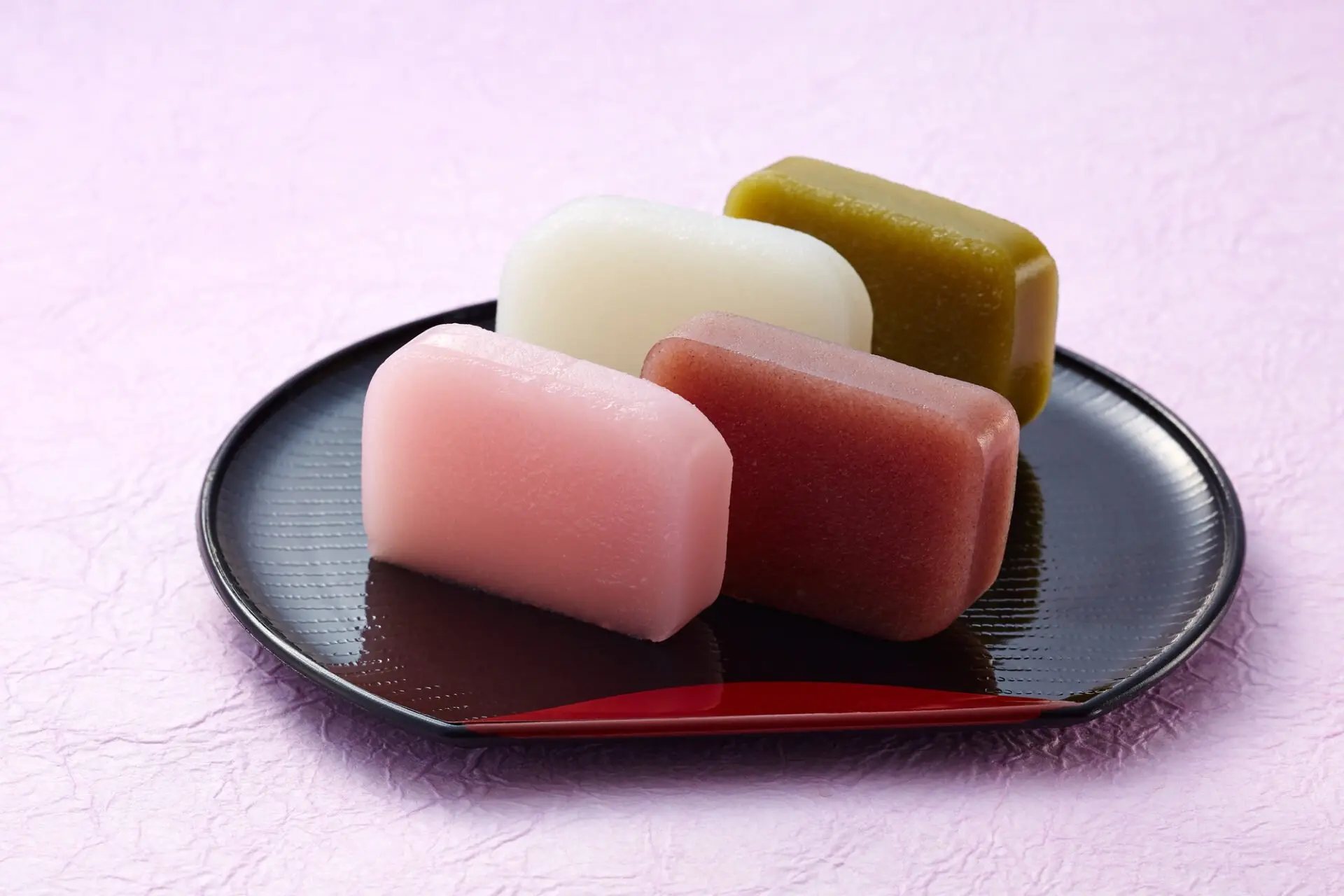Uiro: A Traditional Japanese Sweet with Unique Transparency and Soft Texture
Uiro is a traditional Japanese confection loved by many for its unique translucent appearance and soft texture. While it may seem simple at first glance, its history is deep and closely intertwined with Japanese culture. Let’s explore the charm of this unique wagashi.
The Origins of Uiro: From Medicine to Confectionery
The origins of uiro are surprisingly linked to medicine. The story begins in the Muromachi period with a person named Chen who came to Japan from China. Chen had held the position of “Reibu-ingairou” in China during the Yuan dynasty. After the fall of Yuan, he moved to Japan and adopted the name “Uirou” based on his former title.
The Uirou family practiced medicine for generations and sold a medicine called “Touchinkou.” This medicine was valued for its effectiveness against headaches, coughs, and stomach aches in an era when medical science was not yet advanced. The flagship medicine “Touchinkou” became known as “Uirou” because it was made by the Uirou family.
It is said that the confection uiro was named after this medicine because of its similar color. This is why the Japanese confection uiro is written with the characters “外郎,” originating from the family that sold the medicine.
The Evolution of the Name: From “Gairou” to “Uiro”
The evolution of uiro’s name reflects changes in Japanese pronunciation. The Chinese characters “外郎” (gairou) gradually changed to be pronounced as “uiro” over time. This change is an interesting example of the historical evolution of Japanese phonetics.
The Making of Uiro: Simple Ingredients Creating Deep Flavors
The basic method of making uiro is very simple. The main ingredients are rice flour (or wheat flour), sugar, and water. By mixing these ingredients to make a dough and then steaming it, the unique transparent confection is created.
However, this simplicity is what challenges the skill of the artisan. Slight differences in the ratio of ingredients, steaming time, and steaming method can greatly affect the quality of the final product.

Uiro and Yokan: Two Similar Yet Different Japanese Sweets
While both uiro and yokan are traditional Japanese sweets, there are significant differences in their ingredients and production methods.
| Nutritional content (per 100g) | Uiro | Steamed Yokan (Mushi Yokan) | Neri Yokan |
|---|---|---|---|
| Energy (kcal) | 183 | 242 | 296 |
| Protein (g) | 1.1 | 4.4 | 3.6 |
| Fat (g) | 0.2 | 0.3 | 0.2 |
| Carbohydrates (g) | 44.1 | 55.4 | 70.0 |
| Dietary fiber (g) | 0.1 | 2.9 | 3.1 |
As we can see from this table, uiro tends to have lower energy, protein, and dietary fiber compared to yokan. This is mainly because uiro uses rice flour (or wheat flour) as its main ingredient, while yokan uses red bean paste.
Moreover, uiro has a higher water content compared to yokan. This contributes to uiro’s soft, mochi-like texture. On the other hand, yokan has a lower water content, resulting in a richer taste and longer shelf life.
Types of Uiro: Regional Diversity of Flavors
Uiro is made in various regions of Japan, each with its own characteristics. Let’s introduce three representative types of uiro:
- Nagoya Uiro: Nagoya uiro uses rice flour and sugar as its main ingredients, characterized by its weighty feel and mochi-like texture. At Nagoya Station, you can find a variety of uiro, including not only traditional stick-shaped ones but also photogenic, highly designed products.
- Yamaguchi Uiro: Yamaguchi uiro uses bracken starch, resulting in an elastic, mochi-mochi texture and smooth mouthfeel. Local people affectionately describe its texture as “ottori” (gentle and soft). There are theories that Yamaguchi uiro has been eaten since the Muromachi period.
- Awa Uiro: Its history dates back to the late Edo period, during the time of the 11th shogun, Tokugawa Ienari. During this time, sugarcane was introduced to Awa (present-day Tokushima Prefecture), and the production of “Awa Wasanbon” sugar began. It is said that Awa uiro was created to celebrate the completion of this Wasanbon sugar. Originally, it had a simple flavor using red bean paste, Wasanbon sugar, regular sugar, and salt, but nowadays, seasonal variations with chestnuts or persimmons, and even modern flavors like chocolate have appeared. Its shape varies from square pieces like yokan to round shapes like manju.
These regional uiro reflect the culture and history of each area, providing excellent examples of the diversity in Japanese confectionery culture.
Enjoying Uiro: Optimal Ways to Eat and Store
Uiro is typically eaten at room temperature. Rather than eating cold uiro straight from the refrigerator, allowing it to come to room temperature enhances its soft texture and flavor.
For storage, it’s important to avoid high temperature and humidity. After opening, it’s best to wrap it in plastic wrap and store it in the refrigerator to prevent drying out. However, remember to bring it back to room temperature before eating.
Uiro is a wagashi deeply rooted in Japanese food culture with a long history. Its taste encapsulates the history of its evolution from medicine to confectionery and the efforts of Japanese artisans who have inherited and developed this tradition. When enjoying uiro, it might be interesting to reflect on its rich history and cultural background.
